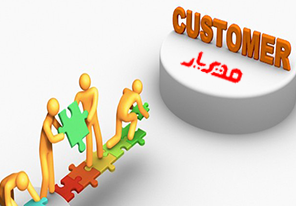سنجش رضایت مشتری و ایجاد مدیریت شکایت مشتریان
رضایت مشتری ضامن تداوم فعالیت سازمانها در بازار رقابت
در سالهای اخیر که امکان پیشرفته تولید انبوه کالاها، زمینه افزایش عرضه کالا را نسبت به تقاضا فراهم نموده است، برای تولیدکنندگان در بازار فشرده رقابت چارهای جز جلب رضایت مشتری باقی نمانده است. افزون بر این، درجهان صنعتی امروز کیفیت اقتصاد رقابتی، فضای انحصاری گذشته را در حیطه تولید کالا و ارائه خدمات درهم شکسته است. به گونهای که درعرصه فعالیتهای اقتصادی جهان نگرش مشتری مداری و کسب رضایت مشتری، یکی از اصول کسب وکار تلقی میشود و عدم توجه به این اصول احتمال، حذف شدن از صحنه بازار را در پی خواهد داشت، زیرا اگر کالا و خدمات، انتظارات مشتری را برآورده کند، در او احساس رضایت ایجاد میشود و با خرید مجدد خود و تشویق دیگران به خرید به بقای آن شرکت کمک می کند. از سوی دیگر در صورتی که کیفیت کالا یا ارائه خدمات سطح انتظارات مشتری را تأمیننکند،بهنارضایتی مشتری منجر خواهد شد و تداوم این عدم رضایت به “کاهش تولید”، “تبلیغمنفی” و سرانجام به “قطع فعالیت آنسازمان” میانجامد. بیل گیتس مدیر شرکت مایکـروسافت در این ارتباط میگوید: “ناراضیترین مشتریان، مهمترین منبع عبرت و یادگیری برای یک سازمان محسوب می شوند”. از همین رو، کارشناسان بازاریابی بر این باورند که کسب رضایت مشتری از سه طریق به افزایش درآمد و سود شرکتهای خدماتی یا تولیدکننده کمک میکند: تکرار خرید مشتری، خرید کالای جدید و خرید کالا توسط مشتریان جدیدی که به علت تشویق مشتریان راضی به خرید کالا از آن سازمان راغب شده اند. به همین علت در کشورهای صنعتی برنامه ارتباط مستمر با مشتریان در سرلوحه تمام برنامههای بازاریابی عرضهکنندگان انواع کالا و خدمات قرار دارد و در این راستا هرگز به یک بار فروشبهمشتری رضایت نمیدهند. نکته مهم و قابل تأمل در فرایند ارتباط با مشتری این است که در صورت نارضایتی مشتری و رویگردانی وی از خرید مجدد کالا تمامی مکانیسم ها در جهت عکس عمل میکند، به گونه ای که برنامهریزی تولید را مختل مینماید و درآمد و سود عرضه کننده کالا را کاهش می دهد و ممکن است ورشکستگی تولیدکننده را در پی داشته باشد. بررسیهای کارشناسان امور اقتصادی و بازاریابی بیانگر این واقعیت انکارناپذیر است که مشتریان ناراضی در انتقال احساس و تجربه خود به دیگران فعال تر و موفق تر عمل میکنند. یا میتوان چنین نتیجه گرفت که سود در تجارت، مستلزم مراجعه دوباره مشتری است، زیرا مشتریانی که به داشتن کالا یا خدمات شما مباهات میکنند، دوستانشان را هم به مصرف کالا یا خدمات شما تشویق می نمایند. از این رو، در مقوله بازاریابی، فرآیندجلب رضایت مشتری از اهمیت ویژه ای برخوردار است و برای این منظور تمهیدات گوناگونی درنظر گرفته می شود که از آن جمله میتوان به “شناسایی انتظارات مشتری”، “طراحی کالا و خدمات براساس نیازها و انتظارات مشتری”، “بهبود در تولید و تسریع در تحویل و خدمات بعد از فروش”، “مدیریت بررسی انتظارات مشتری”، “سنجش رضایت مشتری و ایجاد مدیریت شکایت مشتریان” اشاره نمود. در ضمن برای کسب نتیجه مطلوب در چرخه بهبود رضایت مشتری، توجه به انتقادات و نیازهای مشتری، درک عمیق از آنچه که مشتری می خواهد زمینه ای را برای یک سازمان میسر میسازد تا از طریق روشهای تجزیه و تحلیل راهکارهای مناسب را برای جلب رضایت مشتری پیدا کند و به اجرا گذارد. یکی از صاحبنظران علوم اقتصادی در مورد راهکارهای جلب رضایت مشتری اظهار میدارد: “اگر میخواهید در میدان تجارت و رقابت باقی بمانید، کالای متنوع عرضه کنید و به نحوه ارائه آن تنوع بخشید به گونه ای که کالای تولیدی یا خدمات شما از نظر کیفیت و ارائه با سایر رقبا فرق داشته باشد”. زیرا تجربه نشان داده است مشتریها به جایی مراجعه می کنند که خدمات و کالای آن متفاوت باشد. به عنوان نتیجهگیری میتوان مطرح نمود که همسو با تحولات بازارهای کشورهای صنعتی همه فعالان عرصه کسب و کار باید نگرش خود را متحول کنند.
منبع: www.tici.com
It’s a well known fact that no business can exist without customers. In the business of Website design, it’s important to work closely with your customers to make sure the site or system you create for them is as close to their requirements as you can manage. Because it’s critical that you form a close working relationship with your client, customer service is of vital importance. What follows are a selection of tips that will make your clients feel valued, wanted and loved.
1. Encourage Face-to-Face Dealings
This is the most daunting and downright scary part of interacting with a customer. If you’re not used to this sort of thing it can be a pretty nerve-wracking experience. Rest assured, though, it does get easier over time. It’s important to meet your customers face to face at least once or even twice during the course of a project.
My experience has shown that a client finds it easier to relate to and work with someone they’ve actually met in person, rather than a voice on the phone or someone typing into an email or messenger program. When you do meet them, be calm, confident and above all, take time to ask them what they need. I believe that if a potential client spends over half the meeting doing the talking, you’re well on your way to a sale.
2. Respond to Messages Promptly & Keep Your Clients Informed
This goes without saying really. We all know how annoying it is to wait days for a response to an email or phone call. It might not always be practical to deal with all customers’ queries within the space of a few hours, but at least email or call them back and let them know you’ve received their message and you’ll contact them about it as soon as possible. Even if you’re not able to solve a problem right away, let the customer know you’re working on it.
A good example of this is my Web host. They’ve had some trouble with server hardware which has caused a fair bit of downtime lately. At every step along the way I was emailed and told exactly what was going on, why things were going wrong, and how long it would be before they were working again. They also apologised repeatedly, which was nice. Now if they server had just gone down with no explanation I think I’d have been pretty annoyed and may have moved my business elsewhere. But because they took time to keep me informed, it didn’t seem so bad, and I at least knew they were doing something about the problems. That to me is a prime example of customer service.
3. Be Friendly and Approachable
A fellow SitePointer once told me that you can hear a smile through the phone. This is very true. It’s very important to be friendly, courteous and to make your clients feel like you’re their friend and you’re there to help them out. There will be times when you want to beat your clients over the head repeatedly with a blunt object – it happens to all of us. It’s vital that you keep a clear head, respond to your clients’ wishes as best you can, and at all times remain polite and courteous.
4. Have a Clearly-Defined Customer Service Policy
This may not be too important when you’re just starting out, but a clearly defined customer service policy is going to save you a lot of time and effort in the long run. If a customer has a problem, what should they do? If the first option doesn’t work, then what? Should they contact different people for billing and technical enquiries? If they’re not satisfied with any aspect of your customer service, who should they tell?
There’s nothing more annoying for a client than being passed from person to person, or not knowing who to turn to. Making sure they know exactly what to do at each stage of their enquiry should be of utmost importance. So make sure your customer service policy is present on your site — and anywhere else it may be useful.
5. Attention to Detail (also known as ‘The Little Niceties’)
Have you ever received a Happy Birthday email or card from a company you were a client of? Have you ever had a personalised sign-up confirmation email for a service that you could tell was typed from scratch? These little niceties can be time consuming and aren’t always cost effective, but remember to do them.
Even if it’s as small as sending a Happy Holidays email to all your customers, it’s something. It shows you care; it shows there are real people on the other end of that screen or telephone; and most importantly, it makes the customer feel welcomed, wanted and valued.
6. Anticipate Your Client’s Needs & Go Out Of Your Way to Help Them Out
Sometimes this is easier said than done! However, achieving this supreme level of understanding with your clients will do wonders for your working relationship.
Take this as an example: you’re working on the front-end for your client’s exciting new ecommerce endeavour. You have all the images, originals and files backed up on your desktop computer and the site is going really well. During a meeting with your client he/she happens to mention a hard-copy brochure their internal marketing people are developing. As if by magic, a couple of weeks later a CD-ROM arrives on their doorstep complete with high resolution versions of all the images you’ve used on the site. A note accompanies it which reads:
“Hi, you mentioned a hard-copy brochure you were working on and I wanted to provide you with large-scale copies of the graphics I’ve used on the site. Hopefully you’ll be able to make use of some in your brochure.”
Your client is heartily impressed, and remarks to his colleagues and friends how very helpful and considerate his Web designers are. Meanwhile, in your office, you lay back in your chair drinking your 7th cup of coffee that morning, safe in the knowledge this happy customer will send several referrals your way.
7. Honour Your Promises
It’s possible this is the most important point in this article. The simple message: when you promise something, deliver. The most common example here is project delivery dates.
Clients don’t like to be disappointed. Sometimes, something may not get done, or you might miss a deadline through no fault of your own. Projects can be late, technology can fail and sub-contractors don’t always deliver on time. In this case a quick apology and assurance it’ll be ready ASAP wouldn’t go amiss.
Conclusion
Customer service, like any aspect of business, is a practiced art that takes time and effort to master. All you need to do to achieve this is to stop and switch roles with the customer. What would you want from your business if you were the client? How would you want to be treated? Treat your customers like your friends and they’ll always come back.








